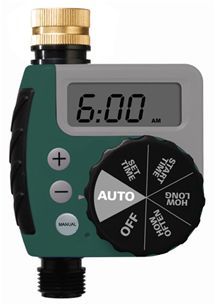Originally posted by ncampion
| Quote: | Originally posted by Jim/Liisa
| Quote: | Originally posted by MitchMan
FWIW, if you just need a couple of trees or certain few plants irrigated in your absence from Baja, here's a simple solution. Home Depot or OSH or
Lowe's in USA has a AA battery operated valve that that can serve one or two hoses. Simply screw this valve directly on the spigot and leave the
spigot open. I use the spigot that would serve the outside provision for a washing machine, that way my tinaco on top of the house can supply a
constant anytime supply of water.
Once the valve is screwed onto the spigot, use reguler garden hose to get close to or in between the two or three plants you want to irrigate. At the
end of the hose, screw on a 1 foot lenght of another hose (spare hose and cut it at 1 foot length. Stuff a 1 foot length of 1/4 inch plastic tubing
in it and put a "T" at the other end of the 1 ft plastic tube. Use more 14 inch plastic tube to go from the "T" to the plants. Done.
The battery powered valve cost about $25-$35 USD. I have used this system for the past year to irrigate my orange tree, the mango tree and the lime
tree and it works flawlessly and reliably. I will be back in Baja at the end of the month and will post photos of my system to make it clearer and
easier to understand if anyone is interested.
It's cheap, it's easy to do, will work for more than three plants, only needs minimal water pressure. |
MitchMan,
Don't mean to scare you but if the water is very hard like it is at my home in Calif. The interior valve will build up with calcium and if your lucky,
it will freez up on the closed cycle but mine always froze up on the open cyclel.
I have tried several makes and they all have done the same thing. Had used them for my Koi pond to keep it toped off during the summer heat. Lucky for
Me they failed while I was home, not in Mexico. Lucky for Me we have our Son home most of the time.
I quite using them for that reason. |
I'm using similar valves at my house in Loreto and have heard about the "stuck open" problem from another person. Is there any way to "de-calcify"
them periodicly, maybe with viniger or something? I guess you would have to keep it from the electronics. Any thoughts, David???
|











